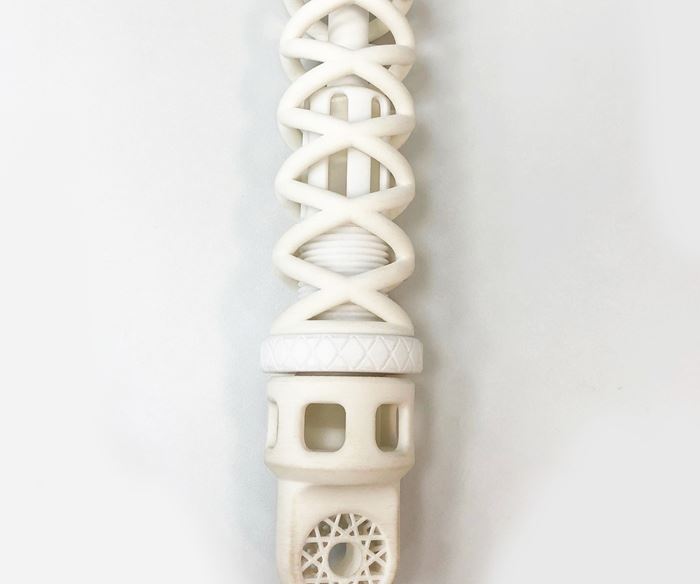Unique 3D-Printed Shock Absorber
Recently showcased by Covestro, this part is printed in three materials using three different processes and boasts a high degree of functionality.
A unique 3D-printed complex demonstrator for a shock absorber was showcased at Fakuma 2018 by Covestro. According to the company, this part marks another milestone in the move from the creation of individual prototypes to the integration of various functions and mass production. In addition to the high degree of functionality attributed to this shock absorber, it is unique in that the individual parts were produced from three different materials and with the aid of three different manufacturing processes:
● The outer spring of the 40 x 7 cm/15.7 x 2.8 in. part is made of powdered TPU. It was shaped layer by layer using selective laser sintering (SLS) and is notable for its elasticity and high abrasion resistance.
● Because the adjusting screw inside the shock absorber has to be very strong and hard, it is made of filaments of Covestro's robust PC material, using the fused filament fabrication (FFF/FDM) process.
● The air chamber in the interior is created from a liquid PUR resin. The digital light processing method has proven itself for such components with filigree structures – as in this case as well.
The individual components are subsequently connected to each other. Said Lukas Breuers, a marketing manager for 2D and 3D printing at Covestro, "This complex structure would not have been possible with conventional production processes. Another new development is the combination of different materials with various, tailor-made properties. This has enabled us to significantly expand the possibilities of additive production and its areas of application.”
Related Content
-
Carbon fiber, bionic design achieve peak performance in race-ready production vehicle
Porsche worked with Action Composites to design and manufacture an innovative carbon fiber safety cage option to lightweight one of its series race vehicles, built in a one-shot compression molding process.
-
Cryo-compressed hydrogen, the best solution for storage and refueling stations?
Cryomotive’s CRYOGAS solution claims the highest storage density, lowest refueling cost and widest operating range without H2 losses while using one-fifth the carbon fiber required in compressed gas tanks.
-
McLaren celebrates 10 years of the McLaren P1 hybrid hypercar
Lightweight carbon fiber construction, Formula 1-inspired aerodynamics and high-performance hybrid powertrain technologies hallmark this hybrid vehicle, serve as a springboard for new race cars.

















